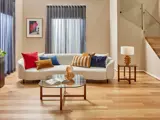Depending on the brand, rugs tend to come in three standard sizes; small (160 x 230 cm), medium (200 x 300 cm) and large (250 x 350 cm or more). However, it’s sometimes tricky to know which size will work with which space. Interior decorator and author, Tahn Scoon talks us through, room by room…
Open plan living areas:
The purpose of a rug in an open plan living area is to add comfort of course, but it should also delineate the living space from the other areas. For this reason, a small rug in front of the sofa just doesn’t work (and looks kind of silly). You need something bigger. For an average-sized open plan space, try a 200 x 300 cm rug with the front feet of furniture placed on it. (You sometimes hear it’s best to have a rug large enough to accommodate all the furniture but this only works in a very large space, otherwise the corners of the rug can encroach on walkways and become a tripping hazard).
Separate living rooms:
Large separate living rooms can be treated much the same as above; select a large rug and place all four legs of furniture on it (leave approximately 20-cm of space between the rug and the walls), or select a medium rug and place just the front feet of furniture on it. A small separate living room is probably the only space that can take a small rug – in this case, place the rug in front of the sofa.
Kitchens:
Whilst rugs can be a pain in the kitchen as you’ll need to shake them out regularly, they can also be aesthetically pleasing, adding warmth and texture to all those otherwise hard surfaces. They can also be practical in terms of protecting bare feet from cold floors and dropped plates from hard tiles. Material wise, an indoor-outdoor rug will probably be your best solution. Size wise, for most kitchens a runner (placed approximately 15 cm back from your kitchen sink cabinetry) will suffice.
Dining rooms:
As in the kitchen, the consideration before deciding to add a rug to the dining room is cleaning. Obviously bare floors are easier to clean than rugs. Having said that, if it’s good looks and comfort you’re after, a rug under the dining table can look great. Keep in mind synthetic rugs will be cheaper to replace and easier to clean than those made from natural fibres (you can also get them treated for extra protection). Technically, the rug should be 80 cm larger than your table on all sides, this is so you can slide chairs in and out without catching on the rug (or scratching the floor boards). However, aesthetically, 80 cm looks too large to me so I must admit, I generally compromise and select a rug 50 cm larger than my table.
Hallways:
Rugs are a great way to style up a hallway and are extremely practical in terms of noise control. A common problem though is most off-the-shelf hall runners are too short, which doesn’t look great (almost as bad as curtains that awkwardly sit inches above the ground). Whilst you can have rugs custom sized, a cheaper solution is to buy two affordable runners and have them sewn together – look for a local carpet overlocker on-line.
Main bedrooms:
Ideally in a main bedroom, you’d have a rug big enough to fit under your entire bed and then protrude out at least a metre or so on all sides (so your feet stay nice and warm). However, rugs this large are expensive – so a cheaper option is to go with a medium rug (approx. 200 x 300 cm) and slide it horizontally under your bed (from the bottom of the bed, stopping just before you reach your bedsides). Presuming you have a king bed, you’ll have a walkway of approximately 50 cm around the bottom and sides of your bed (and a slightly bigger walkway if you have a queen).
Children’s bedrooms:
Young children often have their beds against a wall, to allow for more floor area (and to prevent the odd tumble out of bed) – so in this case, in the average sized kid’s room (which admittedly isn’t very big these days) you’ll only need a small rug (approx. 160 x 230 cm) to create a comfortable play area. However, if the bed is placed in the centre of the room, a bigger rug will be needed.







